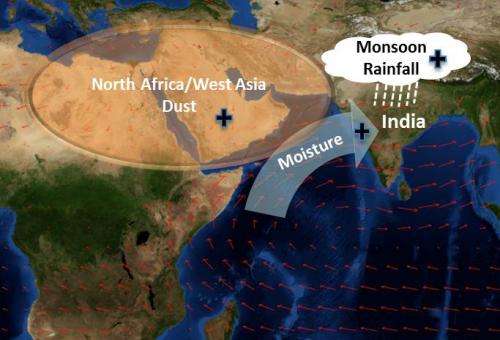Dust kicked up in Asia strengthens Indian monsoon within a week

A new analysis of satellite data reveals a link between dust in North Africa and West Asia and stronger monsoons in India. The study shows that dust in the air absorbs sunlight west of India, warming the air and strengthening the winds carrying moisture eastward. This results in more monsoon rainfall about a week later in India. The results explain one way that dust can affect the climate, filling in previously unknown details about the Earth system.
The study also shows that natural airborne particles can influence rainfall in unexpected ways, with changes in one location rapidly affecting weather thousands of miles away. The researchers analyzed satellite data and performed computer modeling of the region to tease out the role of dust on the Indian monsoon, they report March 16 in Nature Geoscience.
India relies heavily on its summer monsoon rains. "The difference between a monsoon flood year or a dry year is about 10 percent of the average summer rainfall in central India. Variations driven by dust may be strong enough to explain some of that year-to-year variation," said climate scientist Phil Rasch of the Department of Energy's Pacific Northwest National Laboratory.
Rasch, V. Vinoj of the Indian Institute of Technology Bhubaneswar, India, and their coauthors wanted to explore a correlation that appeared in satellite records: higher amounts of small particles called aerosols over North Africa, West Asia, and the Arabian Sea seemed to be connected to stronger rainfall over India around the same time. The team wanted to see if they could verify this and determine how those particles might affect rainfall.

To explore the connection, the team used a computer model called CAM5 and focused on the area. The model included manmade aerosols from pollution, and natural sea salt and dust aerosols. First, the team ran the model and noted a similar connection: more aerosols in the west meant more rainfall in the east. Then they systematically turned off the contribution of each aerosol type and looked to see if the connection remained.
Dust turned out to be the necessary ingredient. The condition that re-created stronger rainfall in India was the rise of dust in North Africa and the Arabian peninsula.
To see how quickly dust worked, they ran short computer simulations with and without dust emissions. Without dust emissions, the atmospheric dust disappeared within a week compared to the simulation with dust emissions and rainfall declined in central India as well. This indicated the effect happens over a short period of time.
But there was one more mystery, how did dust do this to rainfall? To explore possibilities, the team zoomed in on the regional conditions such as air temperature and water transport through the air.
Their likeliest possibility focused on the fact that dust can absorb sunlight that would normally reach the surface, warming the air instead. This warmer dust-laden air draws moist air from the tropics northward, and strengthens the prevailing winds that move moisture from the Arabian Sea into India, where it falls as rain.
Although dust plays a role in strengthening monsoons, this natural phenomenon does not overpower many other processes that also influence monsoons, said Rasch. Other extremely important factors include the effect of temperature differences between land and ocean, land use changes, global warming, and local effects of pollution aerosols around India that can heat and cool the air, and also affect clouds, he said.
"The strength of monsoons have been declining for the last 50 years," he said. "The dust effect is unlikely to explain the systematic decline, but it may contribute."
More information: V. Vinoj, Philip J. Rasch, Hailong Wang, Jin-Ho Yoon, Po-Lun Ma, Kiranmayi Landu and Balwinder Singh. Short-term modulation of Indian summer monsoon rainfall by West Asian dust, Nature Geoscience March 16, 2014, DOI: 10.1038/NGEO2107
Journal information: Nature Geoscience
Provided by Pacific Northwest National Laboratory


















